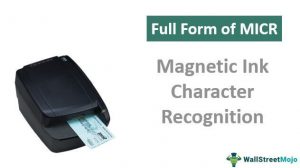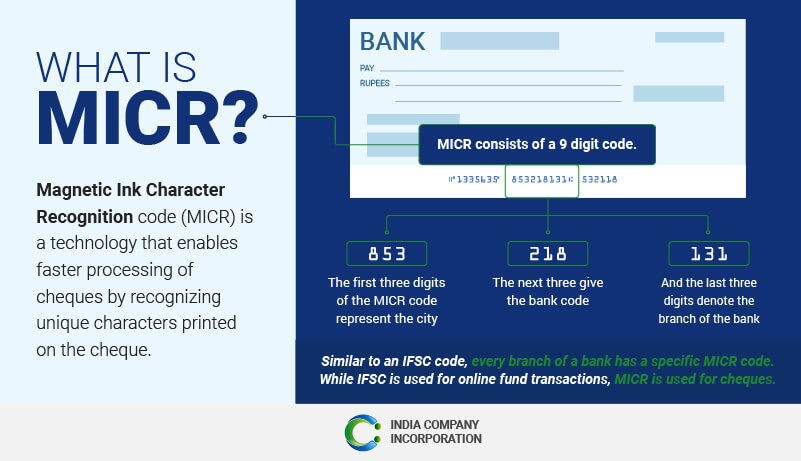MICR (Magnetic Ink Character Recognition) is a technology used to verify the legitimacy and originality of paper documents such as checks. It uses a special ink that reacts to magnetic fields to print specific characters on the original document. Magnetic characters can be used to encrypt information.
 The use of MICR improves security and minimizes losses due to certain types of crimes. When a document is forged, such as a counterfeit check made on a colour copier, the magnetic ink lines either do not react to magnetic fields or produce incorrect codes even when read by a device that can extract the information contained in the magnetic characters.
The use of MICR improves security and minimizes losses due to certain types of crimes. When a document is forged, such as a counterfeit check made on a colour copier, the magnetic ink lines either do not react to magnetic fields or produce incorrect codes even when read by a device that can extract the information contained in the magnetic characters.
Even legitimate checks may be rejected if the MICR reader indicates that the account holder has a history of issuing fraudulent checks.
Retailers use MICR readers to minimize the risk of check fraud. Businesses and government agencies also use them to speed up document management.
Also Read: How to Clean Printer Heads Epson
 What Is MICR Ink | Vs Tenor
What Is MICR Ink | Vs Tenor
What Is MICR Ink
What does MICR mean?
MICR stands for Magnetic Ink Character Recognition, a technology used to enhance the security of personal and business documents.
Checks printed with magnetic ink can be easily recognized by scanners equipped with MICR reading heads. This allows checks to be processed securely, instantly, and with a high degree of accuracy.
Magnetic ink character recognition has become so synonymous with financial transactions that MICR checks have become an industry-standard established by the ABA (American Bankers Association).
How does magnetic ink work?
Magnetic ink bridges the communication between people and computers. Magnetic ink, like bar codes, has a hidden magnetic language that can be read directly by a computer. In addition, MICR fonts resemble natural digital characters that can be read by humans.
Beneath the surface of characters printed with MICR ink are magnetic codes that cannot be read by the human eye. Magnetic ink contains iron oxide particles that become magnetic when printed.
Also Read: Best MICR Printer For Checks
When processed by a MICR reader, the numbers are deciphered based on their magnetic properties, not their appearance.
Rather than interpreting the entire letter, the MICR reader reads the magnetism, which is divided into four parts and deciphers the one corresponding to the number entered. Each character contains two magnetism, positive and negative, along with a linear path.
There are four gates per character, and each check must pass through at least 40 characters and 160 checkpoints before it is processed.
If there is even one discrepancy in the magnetic code, an alarm sounds at the bank counter and the check is manually checked.
What is a MICR font?
 Magnetic ink is used in combination with a unique, positively or negatively charged font to add a protective layer of encryption. there are two types of MICR fonts, E13-B and CMC-7, in use worldwide.
Magnetic ink is used in combination with a unique, positively or negatively charged font to add a protective layer of encryption. there are two types of MICR fonts, E13-B and CMC-7, in use worldwide.
E13-B is the standard MICR font used in North America and elsewhere.
The E13-B font is used for the “MICR line” at the bottom of checks, which contains important information such as account number, routing number, and check number.
The E13-B font consists of 10 numbers and 4 special symbols to represent Transit, Amount, On-Us, and Dash.
Also Read: How to connect a Brother printer to WiFi
![]()
The E13-B font is generally used in the U.S., but countries around the world have opted for the CMC-7 font, which is closer to barcodes.
![]()
The CMC-7 font is used in most European countries and scattered around the world, especially in South America. The characteristics of the barcode result in fewer errors when read by MICR scanners.
The E13-B is often criticized for being too similar in shape and magnetic characteristics to the letters “5” and “2.” If the magnetic wavelength of the “5” is printed incorrectly, it can be mistaken for the correct “2,” resulting in false red flags during check processing.
CMC-7 is often criticized for being technically more accurate, but much more difficult for the human eye to read because each letter is spaced out.
While there are some differences in the fonts of the two, the content processed by the MICR technology is the same.
When processing checks, they must pass through the machine at a very precise rate. If it is processed too fast or too slow, it cannot be read correctly; MICR reading technology has been proven to read checks with over 96% accuracy and rarely results in bad checks.
Also Read: How to Clean a 3D Printer Bed
Why is MICR ink important now?
One could be forgiven for being sceptical of the security measures introduced in the late 1950s. Although magnetic ink character recognition was developed decades ago, it has been improved over the past 60 years and continually pushes the limits of its own protection, forming today’s high-security version of MICR.
Magnetic ink is becoming more and more popular every year. Especially in this day and age, it is possible to get a MICR printer for your business to ensure the security and legitimacy of your documents.
TROY, a manufacturer of MICR printers, has partnered with HP to offer special MICR printers and MICR ink cartridges to the public at reasonable prices.
By installing a MICR printer, you can operate without having to keep an inventory of checks. You can ensure the security of your business by printing only the checks you intend to produce, not pre-printed checks that may be fraudulently filled out.
MICR printing is not only used for check writing. Magnetic ink is used primarily in the financial sector, but it is also being revolutionized in the medical and government sectors.
MICR ink has been used in recent years to guarantee the authenticity of documents such as prescriptions, birth certificates, marriage certificates, and death certificates. In addition, MICR ink adheres to the paper, making it scratch and smudge resistant, thereby preventing counterfeiting. The addition of this encryption code prevents unauthorized attempts and mishandling in various fields.
Because it is extremely difficult to duplicate, MICR printing technology is also a force to be reckoned with in the field of security. It remains the number one security measure in today’s printing world.
Also Read: Which Printer has the Cheapest ink Cartridges
What’s the difference between MICR Ink and MICR Toner?
MICR ink is a magnetic ink used in inkjet printers to print checks, while MICR toner is used in laser printers to print checks.
There are two types of MICR toner: original MICR toner and recycled MICR toner. Both types meet ANSI standards for check printing as long as the ink or magnetic toner cartridge was originally manufactured (not refilled or remanufactured).
Also Read: Cheapest Place To Buy Printer ink Online
What Is MICR Ink | Vs Tenor | Video Explanation
What Is MICR Ink | Vs Tenor | Infographic

Do I need a MICR inkjet or MICR laser printer?
It depends on the number of sheets printed, speed, and security requirements. These factors will help determine the type of control printer you need. Inkjet printers are known to print slower than laser printers, and check printing is no exception.
It is hard to find inkjet printers that can print barcodes at speeds faster than 20 sheets/minute. Inkjet printers also have the disadvantage of being less expandable than laser printers in terms of accessories such as trays, drawers, and security options.
Also Read: How long does printer ink last before it dries up
MICR Workgroup laser printers offer a wider speed range (26 to 62 pages per minute) and additional trays and drawers for different types of checks. They also offer security features such as prohibiting check printing with anything other than MICR toner, restricting access to the check printing process, and protecting and encrypting check data sent to the printer.

